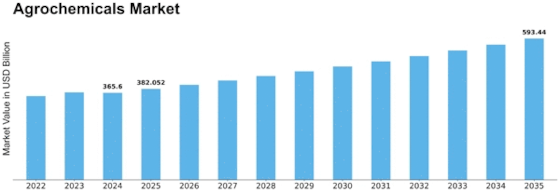The agrochemicals market is witnessing a pivotal transformation as global agricultural demands increase, driven by a growing population and mounting pressure on food security. According to a recent MRFR analysis, the agrochemicals market was valued at USD 365.6 billion in 2024, and is projected to expand to USD 593.44 billion by 2035, reflecting a robust compound annual growth rate (CAGR) of 4.5 percent over the forecast period of 2025–2035. This growth trajectory underscores how central agrochemical solutions — notably fertilizers and pesticides — remain for modern agriculture.
Sustainability is emerging as a major force reshaping the agrochemical industry. The report highlights a clear shift toward greener, more environmentally friendly products. Biopesticides and biofertilizers are gaining traction, partly in response to regulatory pressure and consumer demand for sustainable farming practices. This transformation is not merely a trend; it reflects a broader rethinking of how agrochemicals can support yield without compromising ecosystems. Further, technological integration—particularly precision agriculture—is enhancing efficiency in agrochemical application. Farmers leveraging data analytics, IoT sensors, and digital platforms can apply agrochemicals more precisely, reducing waste and environmental impact while optimizing crop output.
Regulatory environments are also tightening globally, and agrochemical manufacturers are responding with innovation. Stricter safety standards and evolving registration processes are pushing companies to reformulate their offerings and invest in research and development. As a result, the momentum is toward next-gen agrochemicals that are safer, more targeted, and less resource-intensive.
Regionally, the agrochemicals market reflects divergent dynamics: North America continues to be a dominant region thanks to its advanced agricultural infrastructure, innovation capabilities, and strong R&D investment. At the same time, the Asia-Pacific region is emerging as the fastest-growing hub in this sector, fueled by rising demand from densely populated nations, growing commercial farming, and favorable policies to boost productivity. Meanwhile, regions like the Middle East and Africa are becoming increasingly relevant as governments invest in modernizing agriculture to meet food security goals, creating fertile ground for agrochemicals market expansion.
The main drivers behind this growth are manifold. The first is rising food demand: with the global population expected to continue climbing, agrochemicals are critical to improving crop yields and quality. Second, there’s a strong push for sustainable agriculture: agrochemical companies are under pressure to offer products that are less hazardous and more aligned with environmental goals. Third, technology adoption—especially precision farming—is providing a powerful lever to optimize agrochemical use efficiently. And fourth, emerging markets are unlocking major opportunities, as developing countries scale up mechanized farming and chemical inputs to feed their populations.
Looking ahead, the future of the agrochemicals market appears to be anchored in innovation and responsibility. New opportunities lie in the development of precision-application systems that reduce overuse, as well as in eco-friendly formulations such as biofertilizers and biopesticides. The shift toward digital platforms could also transform how agrochemicals are managed and delivered, enabling real-time decision-making for growers.
At the same time, key players in the sector—ranging from global giants like Bayer, BASF, Syngenta, and Corteva to regional leaders such as UPL Limited—will need to adapt their portfolios. According to MRFR, these companies are already focusing on R&D, streamlined registration processes, and portfolio shifts to align with a more sustainable regulatory landscape.
To summarize, the agrochemicals market Growth is poised for sustained growth through 2035. The combination of rising food demand, technological integration, and regulatory evolution is driving a transformation toward more efficient, safer, and eco-conscious agrochemical solutions. For stakeholders across agriculture—and indeed, for anyone interested in the future of food production—understanding these market dynamics is more important than ever.



